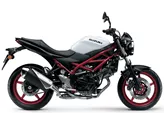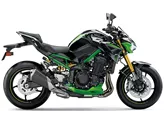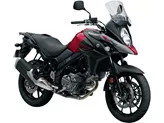Kawasaki Z1000 2014 vs. Suzuki SV 650 2017

Kawasaki Z1000 2014

Suzuki SV 650 2017
Vue d’ensemble - Kawasaki Z1000 2014 vs Suzuki SV 650 2017
The Kawasaki Z1000 model year 2014 and the Suzuki SV 650 model year 2017 are both naked bikes that offer unique features and specifications. Starting with the Kawasaki Z1000 2014, it is equipped with an in-line engine that produces 142 horsepower and 111 Nm of torque. The bike has a four-cylinder configuration and features liquid cooling for optimal performance. With a displacement of 1043 ccm, the Z1000 offers a powerful and thrilling riding experience.
In terms of suspension, the Kawasaki Z1000 2014 is equipped with an upside-down telescopic fork at the front, providing excellent stability and control. The frame of the Z1000 is made of aluminum, which offers a lightweight yet sturdy construction. The braking system consists of double disk brakes with four pistons at the front, ensuring efficient and reliable stopping power.
The dimensions and weights of the Kawasaki Z1000 2014 include a front tire width of 120 mm and a diameter of 17 inches, while the rear tire has a width of 190 mm and the same diameter. The wheelbase measures 1435 mm, providing a stable and balanced ride. The seat height is 815 mm, offering a comfortable riding position for most riders. The fuel tank capacity is 15 liters, allowing for longer rides without frequent refueling.

Kawasaki Z1000 2014
Moving on to the Suzuki SV 650 2017, it is equipped with a V-type engine that produces 76 horsepower and 64 Nm of torque. The bike has a two-cylinder configuration and also features liquid cooling for optimal performance. With a displacement of 645 ccm, the SV 650 offers a smooth and enjoyable riding experience.
In terms of suspension, the Suzuki SV 650 2017 is equipped with a telescopic fork at the front, providing responsive handling and maneuverability. The frame of the SV 650 is made of steel, offering a durable and reliable construction. The braking system consists of double disk brakes with double pistons at the front, ensuring adequate stopping power.
The dimensions and weights of the Suzuki SV 650 2017 include a front tire width of 120 mm and a diameter of 17 inches, while the rear tire has a width of 160 mm and the same diameter. The wheelbase measures 1445 mm, providing stability and control. The seat height is 785 mm, offering a comfortable riding position for most riders. The fuel tank capacity is 13.8 liters, allowing for decent range before refueling.

Suzuki SV 650 2017
In terms of strengths, the Kawasaki Z1000 2014 offers a sophisticated design, extremely pleasant handling, a pleasant sound, and good brakes. On the other hand, the Suzuki SV 650 2017 has a smooth engine, playful handling, and a great chassis.
However, the Kawasaki Z1000 2014 does have a weakness in its high purchase price compared to the Suzuki SV 650 2017. On the other hand, the Suzuki SV 650 2017 has a weakness in its weaker brakes.
In conclusion, both the Kawasaki Z1000 2014 and the Suzuki SV 650 2017 have their own unique features and strengths. The Z1000 offers a more powerful and sporty riding experience, while the SV 650 provides a smoother and more playful ride. Ultimately, the choice between the two will depend on the rider's preferences and priorities.
Caractéristiques techniques Kawasaki Z1000 2014 par rapport à Suzuki SV 650 2017
Avantages et inconvénients en comparaison
Avantages et inconvénients en comparaison
Kawasaki Z1000 2014

La Kawasaki Z1000 (2014) est une déclaration contre la tendance électronique de son époque - et c'est précisément ce qui la rend particulière aujourd'hui. Son quatre cylindres au caractère bien trempé, sa mécanique directe et sa focalisation sans compromis sur l'essentiel répondent aux attentes d'une époque où de nombreuses motos sont devenues des ordinateurs roulants. Oui, elle renonce aux systèmes avancés d'aide au pilote et à une protection parfaite contre le vent. Mais elle offre en contrepartie une authentique expérience de conduite de nakedbike, associée à la fiabilité japonaise et à des coûts d'entretien raisonnables. La Z1000 n'est pas une machine pour les drogués de la fiche technique ou les fans d'électronique - c'est une moto pour ceux qui veulent encore décider eux-mêmes de leur conduite. Une moto honnête avec du caractère, qui continue à enthousiasmer même après des années et qui fait plus que remplir son rôle d'antithèse émotionnelle de la modernité Digital.
Suzuki SV 650 2017

La Suzuki SV 650 est accompagnée d'une longue histoire pleine de succès, qui durera certainement encore longtemps. Son V2 souple convainc par sa réactivité très douce et son couple élevé. Ses dimensions compactes contribuent à donner à la moto un aspect très compact. Cela conviendra parfaitement aux débutants. Le châssis marque également des points avec une maniabilité ludique. Malheureusement, le freinage n'est pas à la hauteur de ce que l'on attend d'un véhicule aussi puissant.
Comparaison des prix Prix moyen du marché Kawasaki Z1000 vs Suzuki SV 650
There are a few key differences between a Kawasaki Z1000 2014 and a Suzuki SV 650 2017. In terms of price, the actual average price of a Kawasaki Z1000 2014 is about 57% higher. Compared to Suzuki SV 650 2017 there are more Kawasaki Z1000 2014 bikes available on the 1000PS.de Marketplace, specifically 12 compared to 6. It takes less time to sell a Kawasaki Z1000 with 75 days compared to 112 days for a Suzuki SV 650. Since model year 2005 1000PS.de editors have written 41 reviews for the Kawasaki Z1000 and 25 reviews for the Suzuki SV 650 since model year 2005. The first review for the Kawasaki Z1000 was published on 9/2/2002 and now has more than 5,800 views. This compares to more than 14,200 views for the first review on Suzuki SV 650 published on 9/26/2008.




















